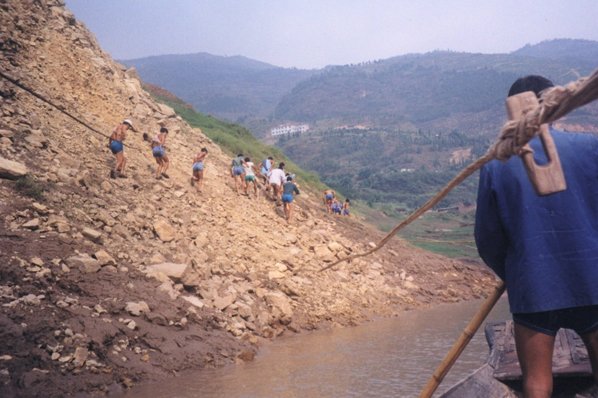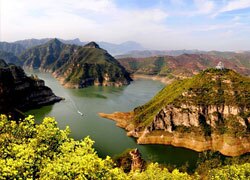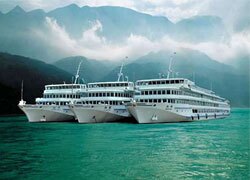The History of the Yangtze River
Winding across 3,988 miles (6,418) of China the Yangtze River is the third longest rive in the world. It begins its journey at the Qinhai-Tibet Plateau and ends at the East China Sea. The Yangtze River has a rich ecosystem, fascinating history, and is the most important river in China.
Early Life on the Yangtze River
Life has always sprung up around the Yangtze River. The earliest signs of life dating back 27 thousand years. The climate on the river is often milder then its cousin the Yellow River making it more suitable for agriculture.

Boat Tracker is one of the earliest occupations along the Yangtze RIver
Yangtze River became an important part of the economy since the Han Dynasty. In 256 BC, during the Warring States Period of China an amazing irrigation system the Kingdom of Quin built, which is still in use today. This irrigation system helped provide a stable farming for China.
It comes as no surprise that by the Song Dynasty those villages along the river became the wealthiest in China. The region of South Yangtze River (Shanghai, Jiangsu and Zhejiang) provided half of China’s revenue.
Ships on the Yangtze River
For 2000 years the Yangtze River was the backbone of transportation of goods in China. In 1835 the first merchant steamboat named the Jardine journeyed down the river. Before steamboats small Chinese ships called Sampan traveled up and down her banks. Jardine was to be a boat used for mail and passenger carrier.
The Chinese were against the steamboat, and said it could not sail on their waters. They attacked Jardine and the British, whose ship it was, retaliated by bringing their warships onto the Yangtze River. This was the start of the Opium Wars. The warships could not be stopped and the empire was forced to surrender. They allowed British steamboats onto the river bringing higher technology to their land.
The British continued to take control of China using the Yangtze River. In 1842 the Qing sued for peace and the Treaty of Nanjing was signed. Britain was opened five ports in China and took Hong Kong. Without the Yangtze River the British would not have been able to conquer China as quickly as they did.
The Japanese took over Shanghai using the Yangtze River by troops on the ground to surround the city. People began to flee the cruelty of the Japanese and their relentless fighting style. They took the perilous journey up the Yangtze River for safety, transporting their families, libraries, and precious art.
The Three Gorges Dam— A Milestone in History of the Yangtze River
 The Three Gorge Dam is the largest hydroelectric power station in the world, which is also a milestone in history of the Yangtze River. It is 7,661 feet long and reaches 607 feet above sea level. It is one of China’s most impressive accomplishments. Construction began in 1994 and the dam became fully functional in 2006. It is still awaiting completion on a ship lift that will increase faster shipping traffic through the Yangtze River.
The Three Gorge Dam is the largest hydroelectric power station in the world, which is also a milestone in history of the Yangtze River. It is 7,661 feet long and reaches 607 feet above sea level. It is one of China’s most impressive accomplishments. Construction began in 1994 and the dam became fully functional in 2006. It is still awaiting completion on a ship lift that will increase faster shipping traffic through the Yangtze River.
The Chinese government was able to push through with the building of the dam with the argument it would decrease the amount of damage done by floods. The river has had several horrific floods since civilization has taken up occupation upon its banks, including the death of over 100,000 in 1911. The most recent flood being in 1998 where 4,150 lost their lives to these waters.
Though the construction of the dam is controversial, it is now supplying 10% of China’s energy, and produces enough electricity to power the lights in New York City, Washington DC, and Boston combined.
Sightseeing along the Yangtze River Today
 Today China is one of the largest importers of goods in the world, but the steamboats have been replaced by freights, diesel tugs, ferryboats, and cruise vessels. The Yangtze River is now one of the prime tourist attractions in China. Travelers book tickets to ride down the Yangtze River to view the Three Gorges, trying to soak in the knowledge this river carries with it.
Today China is one of the largest importers of goods in the world, but the steamboats have been replaced by freights, diesel tugs, ferryboats, and cruise vessels. The Yangtze River is now one of the prime tourist attractions in China. Travelers book tickets to ride down the Yangtze River to view the Three Gorges, trying to soak in the knowledge this river carries with it.
Visitors can take a cruise down the Yangtze River and see her marvels in luxury. Often what is on the itinerary for these cruise ships are stops at the Ghost City of Fengdu, Shennong Stream, Qutang Forge and Qu Gorge, Shibaozhai, and the most marvelous attraction of all the Three Gorges Dam.
Current Situation of the Yangtze River
Nowadays the Yangtze River has become a busy river that contributing thriving economy to its surrounding cities like Chongqing, Wuhan, Nanjing and Shanghai. There are over 57 bridges across over the river connecting North China and South China on various aspects. Taking a Yangtze Cruise Ship has become one of the top 10 travel choices in China for foreign travelers.
On the other hand the rapid development also brings pollution to this great flow. Already several species that live only in the Yangtze River have been lost forever. The Baiji dolphins have not been seen on these rivers since 2007. The Chinese alligator and the Yangtze sturgeon are not far behind it. Factories and pig farms along the river worsen the water.
In all conscience, as a symbol of China with a powerful history, the Yangtze River is an important part to the survival of that nation. It has given life, and it has taken life. A powerful force withstanding time, and abuse, with a majestic flow.
Top Recommend Tours to visit Yangtze River
- Shanghai Sights & Yangtze Combo from $1399
- Beijing Sights & Yangtze Combo from $1549
- Guilin Sights & Yangtze Combo from $1099



